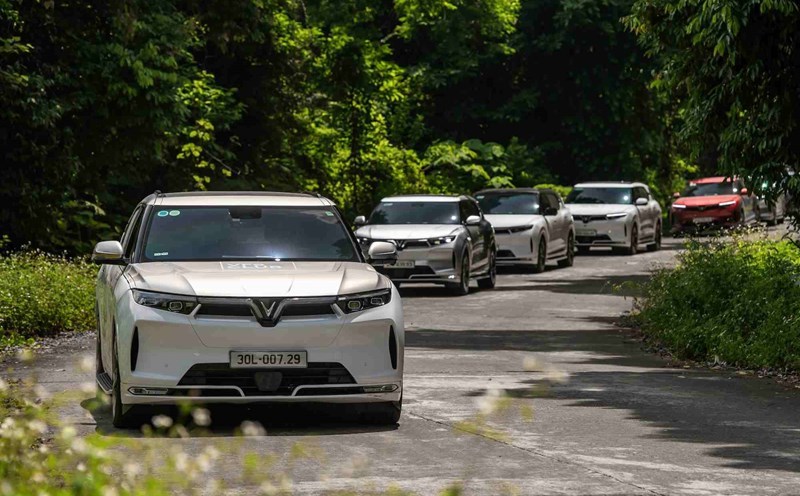Looking forward to your support during the transition
As soon as he read the news that "from 2025 to 2030, Hanoi will ban some types of polluting gasoline cars and motorbikes in Hoan Kiem and Ba Dinh districts", Mr. Tran Ngoc Thai (from Ha Nam) could not help but worry.
Mr. Thai said that the motorbike he is using was bought by his parents 15 years ago. Due to the frequent need to carry heavy goods, the motorbike has shown signs of serious deterioration, emitting black gas. "In case I have to convert my vehicle to an electric vehicle to enter a low-emission zone, I hope the city will support poor workers like me with some of the costs," said Mr. Thai.
According to the Hanoi People's Committee, the national environmental status report 2016-2020 shows that the average annual PM2.5 dust concentration in Hanoi during the period 2018-2020 exceeded the national technical standards by nearly 2 times. The average annual PM10 dust concentration exceeded the limit by 1.3 to 1.6 times.
According to the Hanoi Air Environment Management Plan to 2030, with a vision to 2035, the main sources of on-site air pollution in Hanoi are emissions from road vehicles (the main means of emission in traffic are motorbikes, followed by trucks and taxis) and road dust.
According to the Hanoi Department of Transport, the total number of vehicles managed as of April 2024 includes more than 8 million road vehicles, including about 1.1 million cars and 6.9 million motorbikes. In particular, the number of motorbikes used for more than 10 years accounts for 72.58%, increasing the level of toxic emissions into the air if old vehicles are not maintained according to the manufacturer's recommendations.
Therefore, the issuance of the Resolution on Regulations on the implementation of low emission zones in Hanoi will create a green - clean - beautiful living environment, improve air quality in the area, thereby attracting tourists and investors, and at the same time improve the quality of life of local people.
According to the Resolution, the measures to be applied in the low emission zone are to prohibit the circulation of heavy diesel trucks in the low emission zone. Restrict or prohibit cars that do not meet level 4 emission standards and motorbikes and scooters that do not meet level 2 standards from circulating in the low emission zone according to the time frame/point of time or area...
At the same time, the city will propose policies to support people living and working in low-emission areas, organizations and businesses to convert fossil fuel-powered vehicles to clean energy and zero-emission vehicles.
Regarding the roadmap for implementing low emission zones, from 2025 to 2030, pilot the establishment of low emission zones in an area in Hoan Kiem and Ba Dinh districts (encouraging localities to establish low emission zones).
Speaking to Lao Dong on the morning of December 15, Vice Chairman of the Ba Dinh District People's Committee Nguyen Trung Dung said that the district is currently planning for implementation. "This needs a specific implementation roadmap, it cannot be rushed" - Mr. Dung said.

Switch to electric vehicles, increase public transport
Talking to Lao Dong, Dr. Phan Le Binh - Traffic expert, Chief Representative of OCG Japan Consulting Office, needs to clarify how to identify and distinguish types of motorbikes that do not meet level 2 standards.
According to Dr. Nguyen Xuan Thuy - traffic expert (former Director - Editor-in-Chief of Transport Publishing House), limiting emissions from vehicles, including switching from gasoline vehicles to electric vehicles, is necessary. To do this, according to the traffic expert, Hanoi needs to clarify how to organize, inspect; classify vehicles; need to filter and screen carefully... In addition, there needs to be measuring stations located in some areas to control vehicles entering and exiting.
Mr. Thuy also emphasized that Hanoi needs budget resources to support people to switch to standard motorbikes/electric motorbikes.
According to Associate Professor Dr. Nguyen Quang Toan - former Head of the Road Department (University of Transport), in the process of Hanoi implementing the low emission zone, supporting people to switch to electric vehicles is an important stepping stone. Hanoi needs to have a process of thorough research and study, from which to classify each subject that benefits from the policy of supporting the conversion of electric vehicles to gasoline vehicles.
In addition to supporting people, it is necessary to increase bus routes and public bicycle stations in low-emission areas. With the characteristics of many small alleys in Hanoi, there is also a need for more small buses and electric cars to operate services in these areas.
"Currently, the main source of air pollution in the capital is from road vehicles. If the low emission zone is effectively implemented, the air quality of Ba Dinh and Hoan Kiem districts will certainly improve," Mr. Toan emphasized.
Chairman of the Hanoi People's Committee Tran Sy Thanh said that he has reported to the Government leaders, asking for a study on working with vehicle manufacturers to have a program to reduce motorbikes in low-emission areas. Accordingly, there will be a vehicle exchange program, support for vehicle exchange, and discounts so that people in low-emission areas can use electric vehicles instead of motorbikes.
“People living here need a support program and discounts on car exchange so that people can basically use electric cars. I will have a plan to work with car manufacturing companies. The State, businesses and people must work together to make it clean,” the Chairman of Hanoi emphasized.














